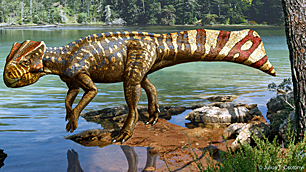Ceratopsian with a Broad Tail – Koreaceratops
The discovery of the remains of a bizarre early ceratopsian (horned dinosaur) from the Korean peninsula has been announced. This small, herbivorous dinosaur, a member of the same family of dinosaurs as the horned giants such as Styracosaurus and Triceratops may have been semi-aquatic – on home on the land and in the water.
The partial skeleton has been excavated from rock that dates to approximately 103 million years ago (Cretaceous – Albian faunal stage). It represents a new genus of primitive Asian ceratopsian and predates other dinosaur finds from south east Asia such as the small, agile, fully bipedal ceratopsian – Graciliceratops (G. mongoliensis).
The fossils of this sheep-sized dinosaur were discovered by a South Korean, Japanese, American and Canadian team of scientists. The results of their study have been published in the online scientific journal Naturwissenchaften: The Science of Nature.
Koreaceratops
This new type of dinosaur has been formally named Koreaceratops hwaseongensis in honour of the South Korean city of Hwaseong (the name translates as “Korean horned face from Hwaseongensis city”).
One the scientists studying the fossils was Dr Michael Ryan of the Cleveland Museum of Natural History.
Dr Ryan commented:
“This is a rare find. Fossils of dinosaurs have not typically been found in this region, whereas evidence of dinosaur eggs and footprints occur more commonly.”
The origin of the ceratopsians can be traced back into the Early Cretaceous, this basal ceratopsian will help fill in the gaps in this particular dinosaur group’s family tree. In a press release, Dr Ryan stated that the discovery of these fossils will help to fill a missing 20-million-year gap in the fossil record between the origin of Ceratopsians in Asia and their first appearance in North America.
Some time after the Ceratopsians evolved, migrations took place and these animals moved eastwards into North America, crossing land bridges that existed linking Asia and the Americas. It was in the United States that giant forms of horned dinosaur evolved towards the end of the Cretaceous, chasmosaurine dinosaurs like Pentaceratops and Triceratops as well as centrosaurines such as Pachyrhinosaurus and Styracosaurus.
The species is represented by a single fossil specimen. The fossil is far from complete, consisting of a significant part of the backbone, including the caudal (tail) section. Parts of the hips and partial hind limbs were also discovered.
The Main Block showing the Partially Articulated Specimen (K. hwaseongensis)

Picture credit: Y. Lee
The block shows the robust, hind limbs with the long tail. Interestingly, the picture shows the very tall neural spines associated with the caudal vertebrae. This indicates that this basal neoceratopsian had a broad, undulating tail. The purpose for the tail, remains open to speculation, but it has been suggested that this little dinosaur may have been semi-aquatic. The broad tail would have helped the animal propel itself through the water. Other basal ceratopsians such as Bagaceratops (B. rozhdestvenskyi) also had tall neural spines on the tail, but this is the first time, that team members at Everything Dinosaur have come across the concept of a “swimming ceratopsian”.
An Artist’s Impression of Koreaceratops hwaseongensis

A swimming ceratopsian?
Picture credit: Julius Csotonyi
Described as a fast, cursorial biped, with a “parrot-like face” and horny beak, Koreaceratops measured about 6 feet long and would have weighed about as much as an Alsatian dog. The skeleton adds weight (no pun intended) to the theory that obligate quadrupedalism (walking on all fours), occurred gradually in neoceratopsians.
The earliest dinosaurs were probably entirely bipedal, evolving through forms that were larger and became facultative quadrupeds (able to walk on two legs as well as all four). Finally the large ceratopsians that lived at the very end of the Mesozoic were entirely quadrupedal.
The broad tail could have been used to store fats to help the animal get through difficult, seasonal conditions, extant Alligators store reserves of fat in their tails to help them survive harsh weather when food may be scarce. The tail could also have evolved as a visual signalling device to attract mates, demonstrate social status in a herd and such like. The wide tail could also have helped to “fool” an attacking theropod , getting it to focus its attack at the “wrong end” as it were.
CollectA produced a model of Koreaceratops, to view this range and the Koreaceratops dinosaur model (whilst stocks last): CollectA Age of Dinosaurs Popular Figures.



